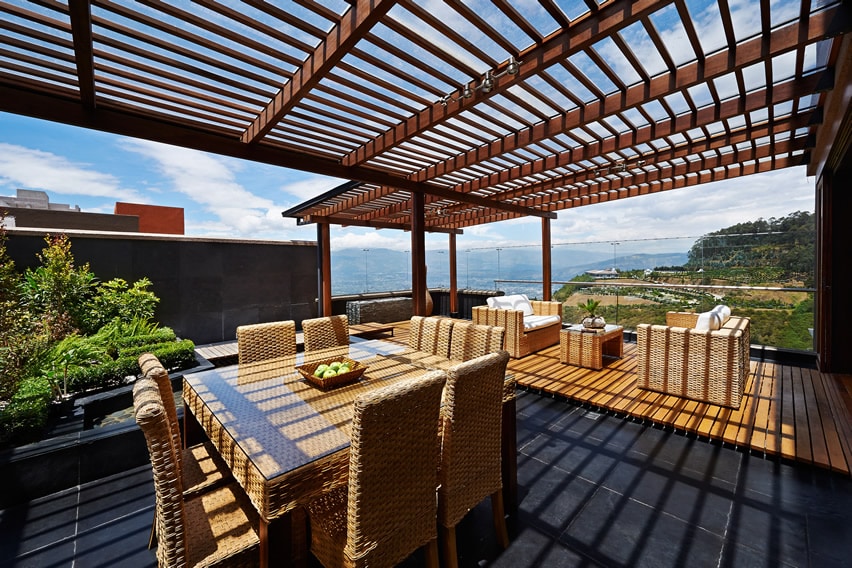Types of Croton Plants (Varieties & Growing Tips)
Croton is a widely popular plant around the world. Bursting with gleaming colors in red, green, orange, and yellow, the calico patchwork of croton leaves are beautiful and interesting all in one. It also grows quite well in most households and offices, which makes it even more desirable as an accent plant or conversation starter. Below we share the popular types of croton plants including ideas on how fast they bloom & grow, sunlight needed and tips on how to plant, care and water your croton plants at home.
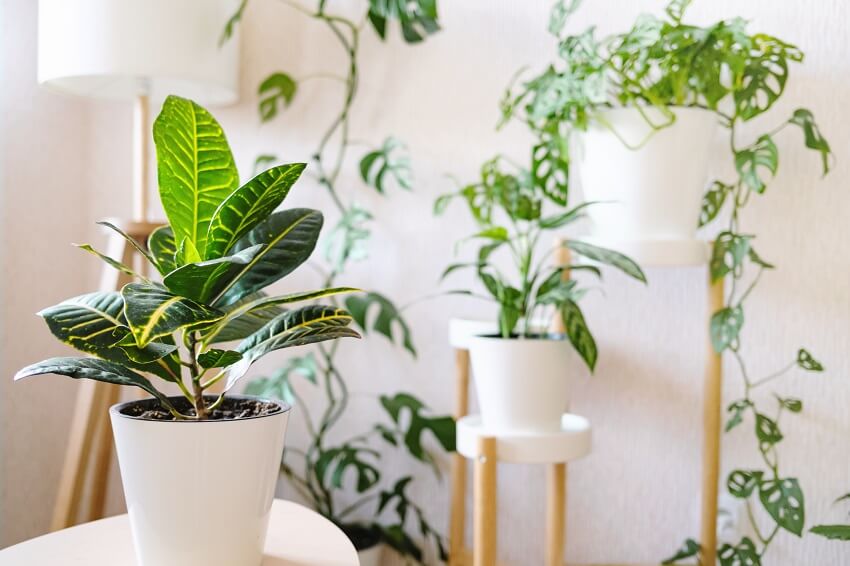
Plants like this are generally hybridized and offered in a variety of shapes and colors, and this one is absolutely no different from the rest! Available in many options, croton can be found at almost any home and garden store or plant shop.
Aside from its obvious allure, croton is a plant that can grow exponentially under the right conditions. If what you are looking for is a fast-growing plant with showy foliage and exotic appeal, then croton is perfect for you.
However, there are lots of different types of croton plants, and it’s always best to do some research to find out first which type you like best before you dive in![toc]
What Is A Croton?
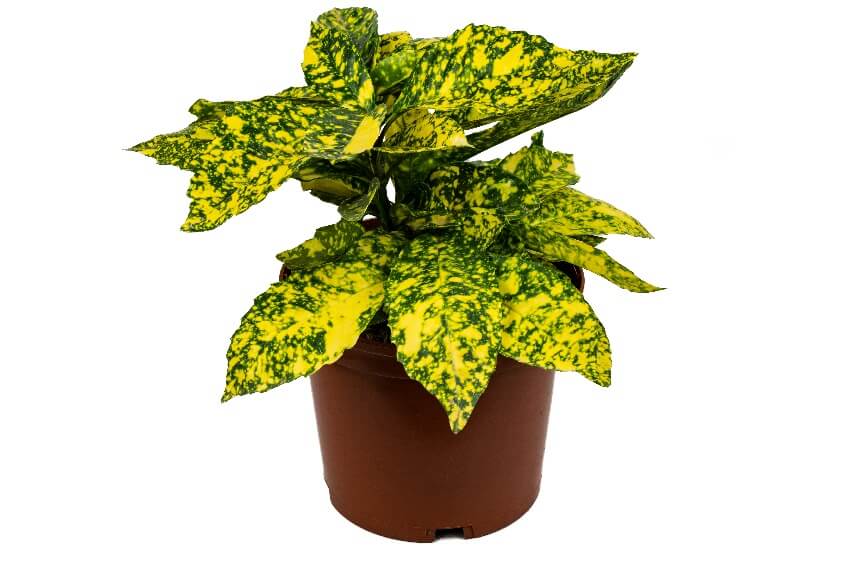
Back in the mid- 1700s, Carl Linnaeus first discovered and named this plant, making it both well-known and heavily cultivated from an early era on. Now, there are countless species of hybrids floating around the market, and many of these can be found for sale at common plant shops and supermarkets.
Easily described as a shrub, croton makes a great houseplant. It takes time to grow as large as your average shrub, especially in colder climates and those with little natural light.
For this reason, they can remain small to medium sized and perfect for most indoor planters. It’s easy to think that croton can grow nearly anywhere, but growing conditions in an indoor environment should ideally reflect its natural habitat. Check out more indoor plants that like direct sunlight here.
Croton Varieties
Among the many tons of different species of crotons out there are a smaller number of those which can be grown in almost any home or office space.
Cleverly placed movie titles aside, even if you aren’t someone who typically likes the look of most houseplants, there’s a croton with your name on it. Here are some of the most beloved and most common subspecies of croton you’re likely to be able to find for sale:
Florida Select Croton
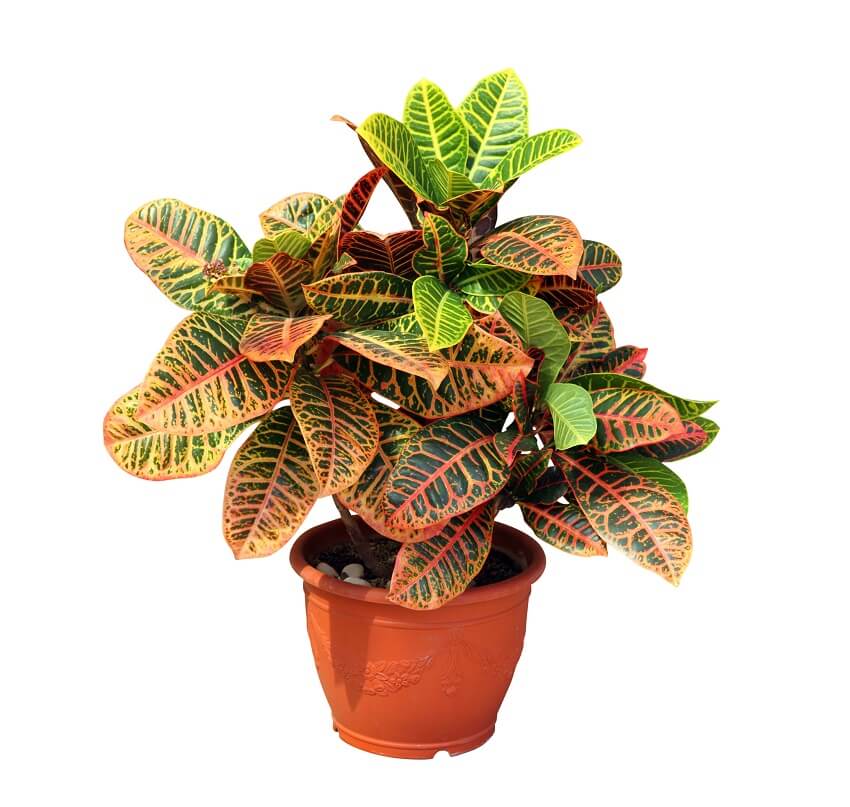
Aside from its grandeur as the most prominent species of croton, this plant likes to keep you happy with very easy care routines and a new leaf almost every week during the growing season.
Emerald green, gold, orange and red are the foremost colors you’ll see on the leaves, but they may occasionally present with a speck of white or two.
Red Iceton Croton
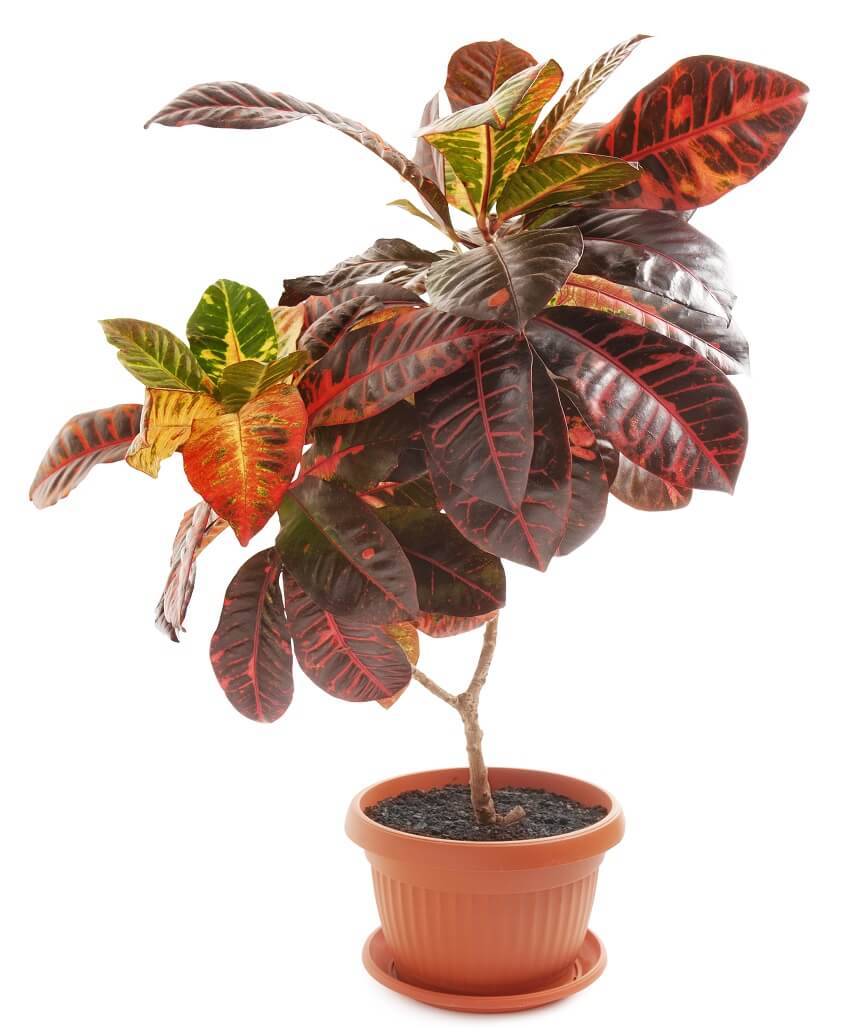
What’s more is that this species grows pretty tall for a croton, and can reach up to 8 feet in height if properly trimmed, fed and repotted.
Red iceton makes a great floor plant and can offer a little dazzle to any larger space, especially around more muted tones.
For more color, add more sunlight, but be mindful of sun spots, or burn marks that may not show up well on lighter colored leaves. Several of these marks indicate that they’re getting too much direct light. Find out more red indoor plants here.
Lauren’s Rainbow Croton

Its narrower, more havily contrasted leaves often show striping of lighter colors like orange and yellow overtop the deep, emerald green that typically comes on any croton.
This unique species can also display purple hues, but too much sunlight can bleach out those violet tones to a greener shade.
To liven it up with some brighter colors instead, offer more hours of filtered sunlight during the day, and you’ll see more of the brightly contrasted striping down the center of each leaf.
Gold Dust Croton

While the leaves are dappled on all plants of this species, the amount of dappling and the consistency of color are different for many individuals, especially those grown in different regions.
Sunnier areas will likely bring out more of the yellow fleck, while gloomy climates may make the plant struggle to produce this coloration.
Nevertheless, as is with most crotons, more sunlight means more yellow; if you don’t have enough natural light coming in through your windows, try an artificial plant light to supplement.
Magnificent Croton
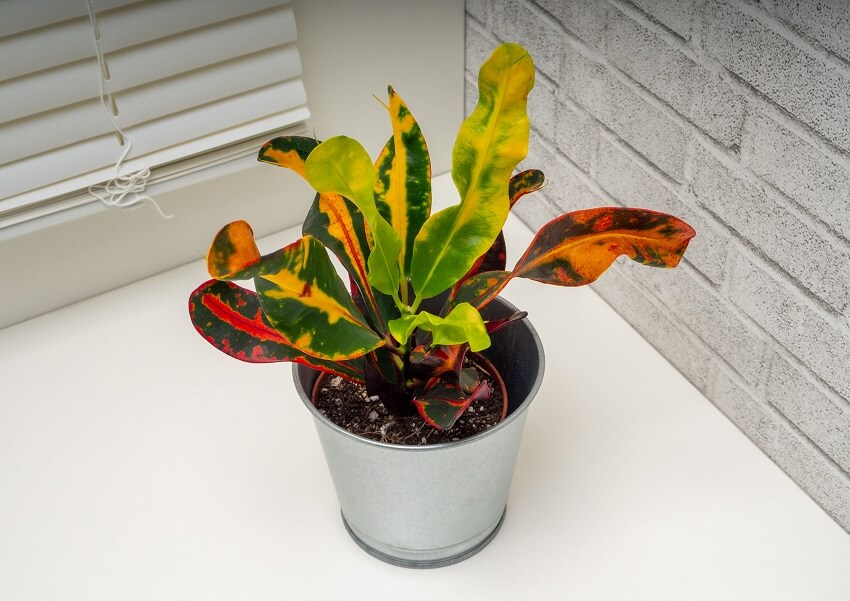
This type consists of spots that can start on the edge of a leaf, the middle, or a tip, but not in any organized manner. These spots are usually large and are red, orange or yellow in color, while the rest of the leaf is a deep, rich green.
This is a great species if you typically prefer variegated plants, and will fit right in with anything that has lighter green or white spots.
Although this species could do well in direct sunlight, it’s best not to stress the leaves by exposing them to full sun all day. A healthy magnificent croton will have both yellow and red splotches, not just one or the other.
Dreadlocks Croton
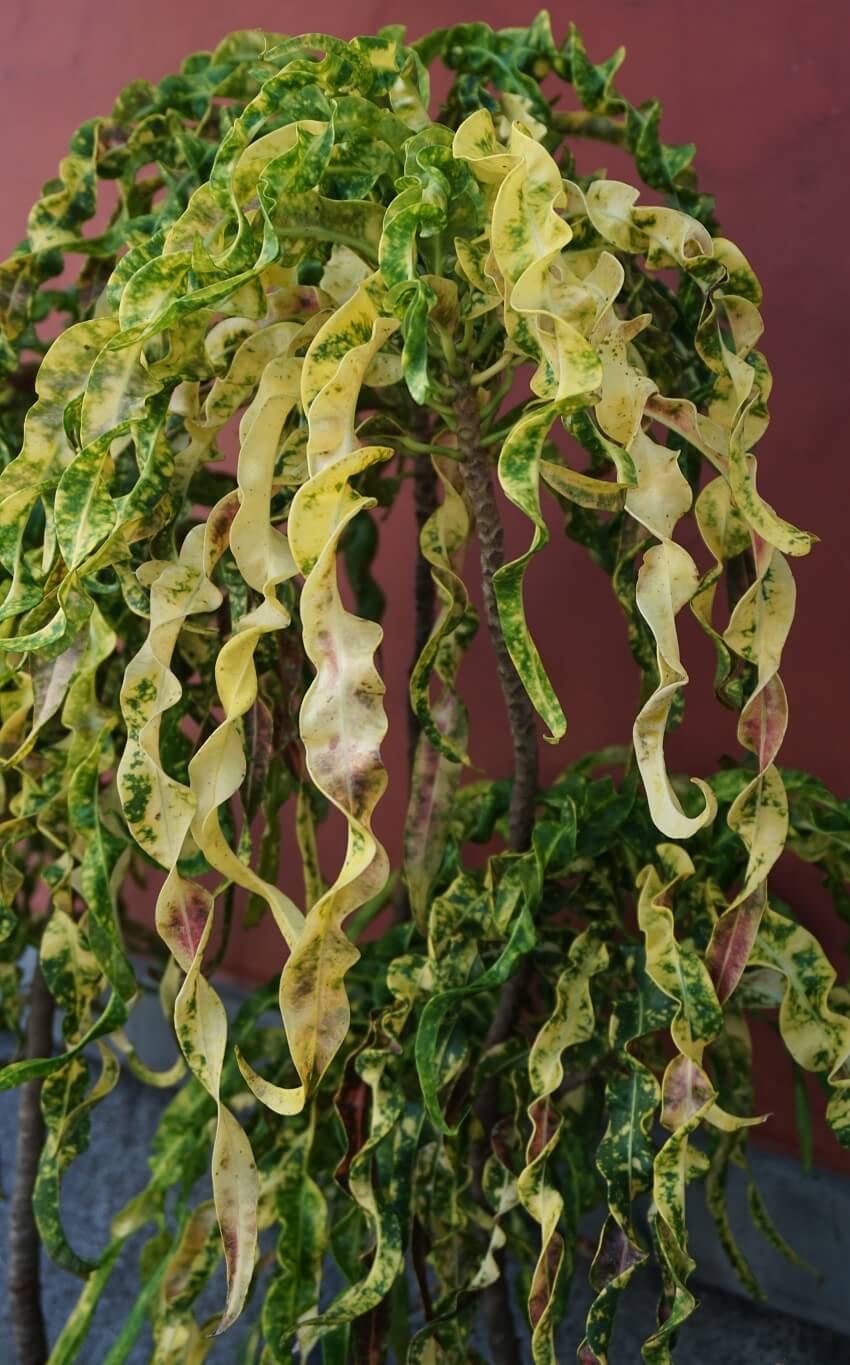
Typically, a dreadlocks croton will remain smaller in a good pot and rarely requires any trimming, yet some older leaves may fall away on their own if they feel they’re no longer useful for photosynthesis.
The colors of each leaf gradually change and fade into new colors as they age; newer colors will be brighter, and older colors will be darker. Medium to bright indirect sunlight is perfect for this species.
Outdoor Croton Types

Nevertheless, croton makes a fantastic outdoor landscaping staple, and brings a tropical and intriguing style to any outdoor space.
It’s important to water outdoor crotons frequently, and to provide them with shade once the summer months are in full swing. If temperatures plummet below 40 degrees, 60 at the ideal range, then you may need to bring your croton in or install a pop-up greenhouse around it to protect from the freezing cold.
Finding the right leaf patterns can be tricky, but there so many options to choose from that at least one of them can be the perfect fit:
Petra Croton
Easily the best species for outdoor growing, petra is resilient and will withstand much more variation in temperature fluctuations than most other varieties. On that note, it is best grown in zones 9-11, though it may tolerate zone 8 with some winter coverage such as mulch or a pop-up greenhouse.
Petra is also a brightly colored plant, laden with more yellow and orange hues than anything; however, the amount of sunlight it gets will determine how it looks.
The fiery color combos of this plant make it an excellent outdoor shrub with minimum care requirements, but drought is less favorable than an extra wet season.
Eleanor Roosevelt Croton
This plant, aptly named after the former First Lady of the United States, is an incredibly sophisticated variety with only gold and green contrasts run along slender, longer leaves.
This variety grows great outdoors in warmer climates, especially due to its shorter stature and less maintenance requirements.
This plant is lots of fun to grow in contrast with brightly colored blooms, such as a buddy pairing with hibiscus or dipladenia. Although it can be harder to find, this croton is well worth the search to plant in your garden or flower bed, and will attract lots of attention throughout.

Mamey Croton
If there was one particularly spicy species to grow outside, it’s this one. This is another variegated variety that loves attention and shows it by displaying brightly colored bursts of rainbow on its wavy leaves, which are a bit different than your average croton.
A Mamey variety falls somewhere between a curly and traditional croton, mamey is a species that loves the sun and will tolerate up to 8 hours of indirect light per day.
It’s best to shade this one in hotter months where the sun is up in the sky for longer hours, which can help prevent sunburn or sun spots from forming on the waxy leaves. This is another somewhat larger shrub, but it can be kept smaller with trimming and routine care.
How Big Do Crotons Get?
Depending on the species, crotons can grow from around two to six feet tall, on average. Smaller, hybridized species with more delicate leaf structures, such as those with curly leaves, will stay on the shorter side.
On the other hand, varieties that tend to hold the traditional leaf shape and growing patterns as crotons found in the wild, similar to Florida Select, will grow much taller and can even be grown into a full shrub or floor plant for a home or office.
You can also trim your croton (carefully) each year to maintain a shorter stature, but this puts stress on plants who already aren’t receiving optimal care and routine maintenance.
Planter size can also play a role in how tall a croton will grow to be ultimately. If you restrict the root growth of a croton plant, it won’t be able to absorb as much water nor as many nutrients as it needs. This will stunt the plant’s growth and should be avoided.
However, if you choose to bonsai a croton, this can be done with religious root trimming, repotting and fertilizing. You can follow basic shrub bonsai guidelines to achieve this, but it’s great to do your own research to find out what other people may have done to accomplish a healthy croton bonsai.
How Fast Do Crotons Grow?
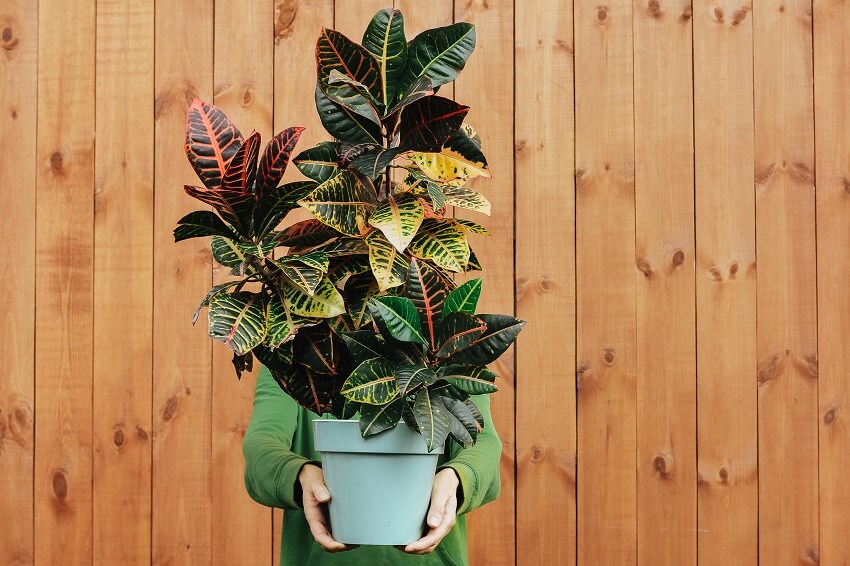
With ample sunlight, food, water, and clean soil, a croton can grow as much as 12 inches in one growing season; so, you’ll have some new growth, but nothing that takes off.
It requires much more energy for such a woody plant to produce new growth than something as thin and flexible as a mint plant. Keeping this in mind, once the growing season is over, you may get lucky enough to see one or two new leaves per month, again in optimal conditions.
If your croton isn’t growing during the growing season, it’s a sign that something is inadequate for it. Your plant either needs more food, water, or humus-rich soil. No matter the cause, very slow or no growth in a year means your plant is begging for more attention, and it isn’t receiving that from you.
Try to watch it after feeding, watering, and repotting to see growth spurts after these care tasks. You can also do some research by region to find out if people in your area are having similar problems, which may help you to narrow down exactly what the culprit is.
Are Crotons Perennials?
The answer to this question is both yes and no, depending again on where you live. Since croton is a tropical plant, it doesn’t go dormant in the wintertime, so any frost it comes into contact with can be fatal.
On that note, croton can absolutely be overwintered indoors; if your croton is in a container, you can simply move it inside to a bright location with lots of indirect sunlight.
However, if your croton is planted in the ground, it will either die off if you’re in zones less than 10; in zones 11-12, which are much more tropical, croton will happily stay outside all winter so long as there are no freak frosts.
Do Crotons Like Full Sun?
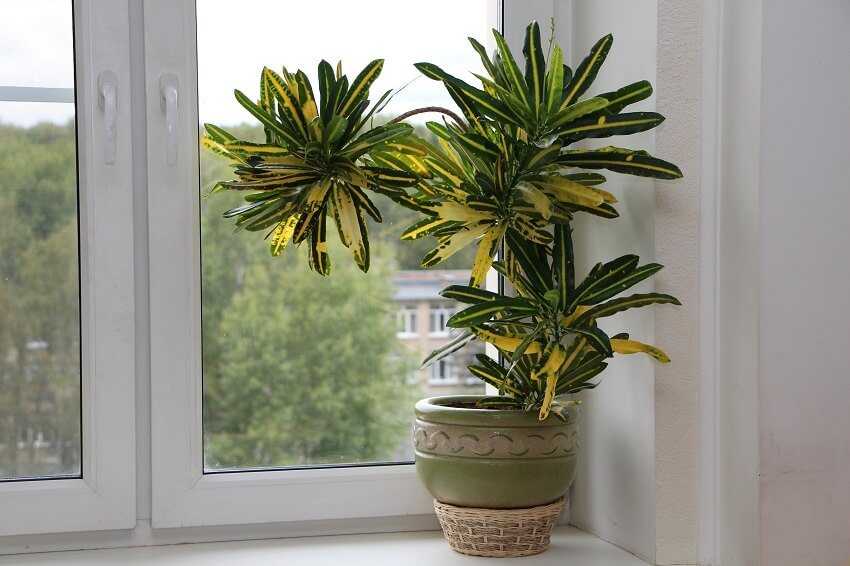
Full sun doesn’t mean sun rays directly piercing the plant, though, make sure that croton receives ample shading from the hottest parts of the day, with either shade cloth or any other shade source to create more indirect lighting.
Indoors, croton should be grown close to a window with sheer curtains or adjacent to a bright window, where it gets light reflected off painted walls.
If you don’t get enough light indoors to sustain a croton alone, try using a full-spectrum LED light (doesn’t need to be a “grow light” brand) within a few feet of the top of the plant to encourage new growth and splashes of color.
Does A Croton Flower?
If a croton is happy enough, it will most definitely flower! This typically happens in summer, but excessive heat or cold will prevent this process. The tiny flowers bore by this plant grow in dense clusters of little yellow blooms, which are very different from most flowering tropical plants.
Instead of your average petals, crotons produce small, sea-urchin-like blooms that produce lots of pollen and will fall off once fertilized. If you don’t like the flowers or would prefer the plant focus instead on growing, you can remove the flower stalk from the stem with a sharp blade.
However, it’s rare to see indoor crotons bloom, so most growers enjoy their presence. If your indoor croton flowers, it means that you’ve done a great job making it feel right at home!
How To Plant A Croton

Essentially, in the tropical and hot climates it comes from, crotons are used to the very rich, acidic soil that decomposing plant matter in these regions tends to create. On that note, most soils formulated for tropical plants are great, especially if they contain perlite or vermiculite and peat.
Once you have a good soil to plant in, fill a container twice the size of the root ball itself (not the pot it came in) about ⅓ of the way full of soil, place in the croton gently, and cover with soil to about an inch away from the top of the pot.
Avoid twisting the plant or compressing dry soil with your hands, which both can damage the sensitive roots in this stage.
How To Care For A Croton
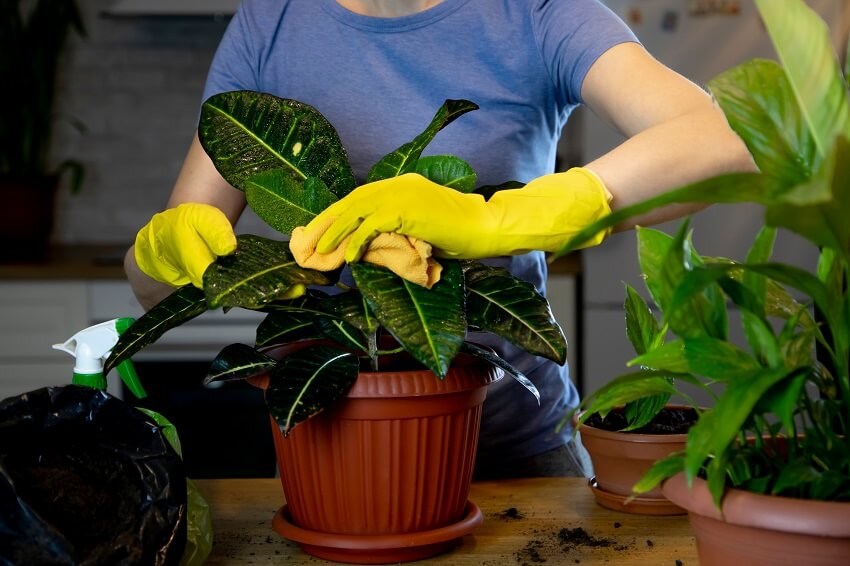
However, this plant should not be over or under watered routinely. Too much or too little water can cause leaves to drop, especially in warmer seasons. Try not to let water sit in the planter, either; drainage holes are a must to prevent root decay from constant exposure to acidic water.
Otherwise, crotons are happy to grow in most indoor climates, particularly more humid ones. They should be given at least 6 hours per day of bright, indirect light, or 8 hours if the light your plant gets is weak or spread out over the course of a day due to shade.
Cleaning the leaves with nothing but a damp washcloth every month will help prevent the buildup of dust, which attaches to waxier leaves like these quite easily.
The dust forms a layer of crud that makes it hard for the plant to photosynthesize, and since you undoubtedly want your plants to look amazing all the time, this is a necessity.
How Often To Water A Croton
While some sources recommend a certain number of days between waterings or times per week, watering a croton is very dependent upon its surrounding environment. In dryer climates, you’ll likely need to water more than in wetter or colder ones.
This in mind, you can tell when it’s time to water by either using a moisture meter, which is relatively cheap and convenient to use, or by simply feeling the soil with your hands.
Poke a finger into the soil to determine if it’s damp; if the first inch of soil is dry, it’s time to water. Pour enough so that the water drains through the bottom, but not so much that soil remains waterlogged, which attracts pests.
If you used a top dressing such as moss or pebbles to cover the soil, a moisture meter is the best way to go. These are usually fairly accurate and last a long time.
How Long Do Crotons Live?
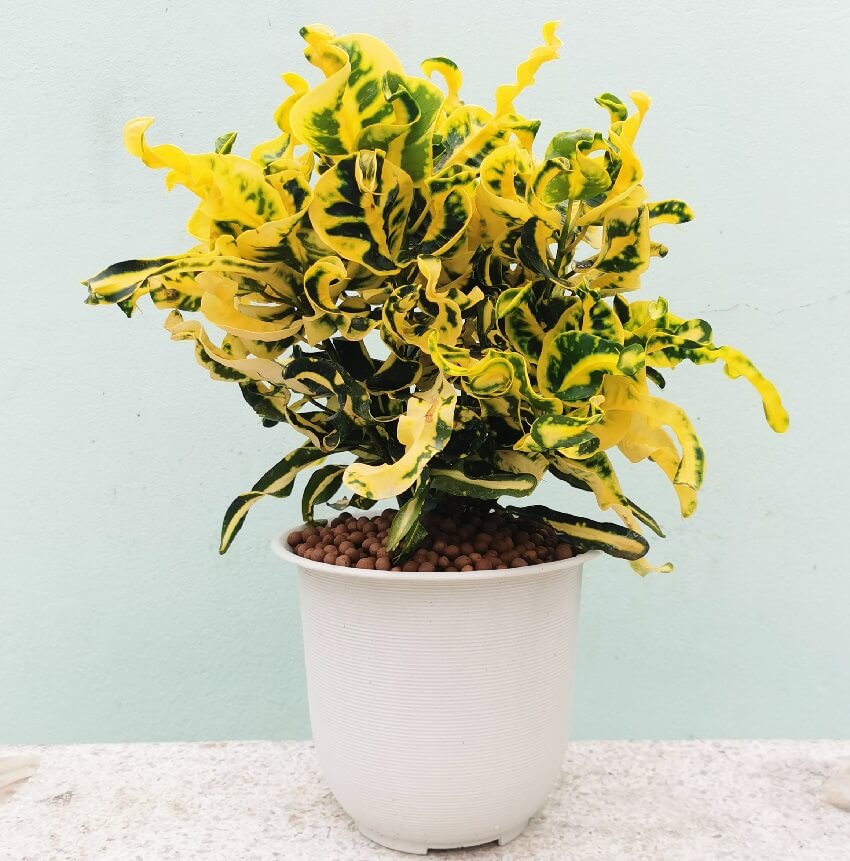
To enhance the plant try to maintain a temperature above 60 degrees and set the humidity at 40 to 80 percent. They also prefer bright light and will provide the best color under a sunny window.
If you want to keep your croton’s spirit alive, you can always take cuttings and root them before the lifespan of your croton comes to end, which will give you brand new plants with the exact same DNA and a reset on their lifespans.
Some highly variegated varieties may not live as long, but nonetheless, they can be grown longer if they’re well taken care of.
Are Crotons Deer Resistant?
Croton aren’t particularly appetizing to deer, and there’s a good reason for that. Croton plants produce a wax-like substance that forms a layer over their leaves, making them unpalatable to most mammals, and rendering them tough and leathery as it is.
An animal would need to be pretty hungry to dine on one of these, and even if it did, the pungent aromas tucked inside the tender shoots are enough to ward off anyone considering taking another bite. They can be buddy planted with other less deer resistant plants to help ward off cheeky munchers, as well.
How Often Do Crotons Bloom?
Unlike many other tropical plants, crotons only bloom when they feel like it’s in their best interest. Therefore, it usually isn’t ideal for them to bloom if they’re indoors.
However, the right light balance can really help things along if you’re determined to see some flowers. Try playing with the amount of light your croton gets each day over the course of several months to see if one particular spot is better for blooming than others.
In greenhouse environments, crotons can bloom year-round, with no resting season. These blooms appear on stalks based on seniority, so the oldest healthy stalk will see flowers first, then those that follow. If the plant becomes unhappy during blooming, such as during a drought, it will drop its flowers quickly.
Plants That Look Like Crotons

Other plants that look similar to crotons can offer the same exotic aesthetic without the tropical climate demands. These plants will thrive in lower zones, even down to zone 6, and can be used almost interchangeably with a croton.
However, there may be some size or shape differences, as well as a lack of those bright red and yellow hues for some. Flowers will also be different, but considering the odd appearance of croton flowers, this will be a plus.
Here are a few plants that look like crotons to check out
• Japanese laurel. This species of laurel is native to areas of China, Japan, and Korea, where they grow in dense fog and chilly air. Since it’s native to colder and wetter climates, Japanese laurel is best grown in similar conditions.
This plant wouldn’t be ideal to grow in warm climates, where a croton would thrive. If you do live in a slightly warmer climate, be sure to provide ample shade from afternoon sun and plenty of water to accommodate for the lack of cool mist.
• Coleus. Another option for fun color arrays is coleus, which can grow either as a houseplant or an outdoor annual in colder climates. This plant is easy to maintain and propagate, will tolerate more sunlight than Japanese laurel, and can even grow to be quite large, if allowed.
Its lifespan is similar to that of a croton plant, but the same methods to preserve it can be used; simply make new starts with cuttings, then plant them! This will replace the mother plant as it begins to die off.
• Caladiums. A very colorful alternative to crotons are caladiums, which come in dappled colors of green, pink, white, or red. Being a tuber, caladiums do have a dormancy period in cold months, but this can be avoided to keep them up as houseplants with small temperature and light changes.
Pink and white varieties seem to be the biggest hits, but red and basic green types are equally delightful in any setting. Caladiums don’t need a ton of light, but they do need enough to make it worthwhile to bear their gorgeous leaves full time. No matter which variety you choose, you likely won’t be disappointed.
Are there any of your favorite types of crotons that we missed. Please comment with the crotoneae you like best or share your best care tips below. For more content like this visit our guide to different types of rubber plants.




